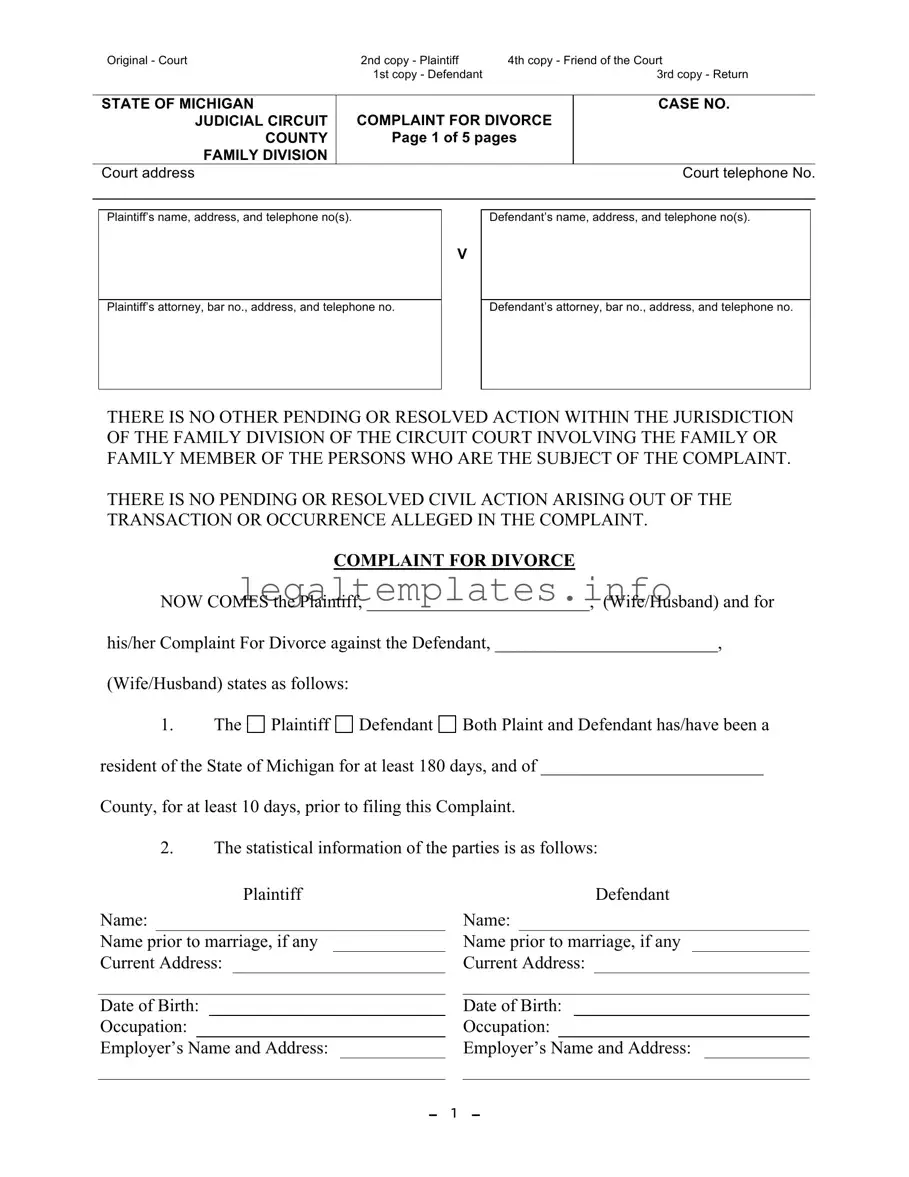The Michigan Complaint for Divorce form, at its core, shares commonalities with a variety of legal documents, each serving a unique purpose but structured to navigate the complexities of law and personal matters similarly. For instance, a Petition for Child Custody is remarkably similar. Both documents require detailed personal information, specify the relationship between the parties, and set forth the requester's desires from the legal proceedings. They provide the court with the necessary background to assess the case, aiming for decisions that best serve the interests of children and the family structure being addressed.
Just like the Complaint for Divorce, a Civil Complaint form initiates legal proceedings. It marks the beginning of a lawsuit in which an individual or entity claims to have been wronged by another and seeks a legal remedy from the court. Both documents outline the parties involved, detail the alleged grievance or breakdown in relations, and lay out what the plaintiff seeks to achieve, whether it be divorce, financial compensation, or another form of relief. The structure and purpose of these forms emphasize their role in facilitating the initial steps toward resolution.
A Separation Agreement contains elements similar to those found within the divorce complaint's section on property and child custody arrangements. Both documents deal with the division of assets, debts, and the determination of child support, custody, and visitation schedules. The key difference lies in their binding nature; a Separation Agreement can be a precursor to divorce, establishing temporary terms, while the Complaint for Divorce seeks to make those terms permanent under the law.
Another comparable document is the Personal Protection Order (PPO) application. While serving a different primary function—protection from abuse rather than dissolution of marriage—both forms necessitate personal information about the parties involved and detailed descriptions of the circumstances leading to the request. They are designed to prompt judicial intervention into private matters for the protection and restructuring of personal relationships.
The Legal Name Change Petition shares the section of the Complaint for Divorce where one party may request the restoration of their maiden name. Both entail a formal request to the court for a change in legal status or identity, driven by personal circumstances. This similarity underscores the role of the courts in recognizing and formalizing changes in personal status.
Eviction Notices, while different in context—landlord-tenant versus marital relationships—mirror the divorce complaint in their structured approach to resolving disputes. They formally notify the recipient of a legal action being taken against them due to a breakdown in agreement, and they provide details of the grievances along with what remedy is being sought.
Bankruptcy Petitions, like divorce complaints, are pivotal in radically altering an individual's legal and personal situation. Both documents require full disclosure of personal and financial information, and both seek the court's intervention to reorganize or resolve these personal affairs, whether financial or relational.
The Last Will and Testament document, although typically not filed in court in the same manner, resembles the Complaint for Divorce in its detailed allocation of assets and responsibilities. Wills specify how an individual’s estate should be handled after their death, much like how a divorce complaint outlines the division of assets and custody arrangements in the wake of a marriage’s dissolution.
Finally, an Adoption Petition echoes the Complaint for Divorce through its focus on family structure. While one brings a marriage to an end, the other creates new family bonds. Both involve detailed disclosure of personal situations and aim to legally formalize significant changes in family dynamics, emphasizing the court's role in personal and relational matters.
In sum, while the Michigan Complaint for Divorce form initiates the process of legally ending a marriage, its structure and requirements find parallels in various legal documents. These documents span the gamut of life's pivotal moments, from restructuring familial relationships to seeking protection or altering one’s financial or personal status, each utilizing the court system to recognize and authorize significant changes.


 Plaintiff
Plaintiff  Defendant
Defendant  Both Plaint and Defendant has/have been a resident of the State of Michigan for at least 180 days, and of _________________________
Both Plaint and Defendant has/have been a resident of the State of Michigan for at least 180 days, and of _________________________
 have
have  do not have property to be divided.
do not have property to be divided. have
have  have not participated as a party or witness or in another capacity, in another child custody proceeding concerning the children.
have not participated as a party or witness or in another capacity, in another child custody proceeding concerning the children. know
know  do not know of a proceeding that could affect the current child custody proceeding, including a proceeding for enforcement or a
do not know of a proceeding that could affect the current child custody proceeding, including a proceeding for enforcement or a
 know
know  do not know of any person who is not a party to this child custody proceeding and has physical custody of the children or claims rights of legal custody or physical custody of , or parenting time with, the children.
do not know of any person who is not a party to this child custody proceeding and has physical custody of the children or claims rights of legal custody or physical custody of , or parenting time with, the children.


